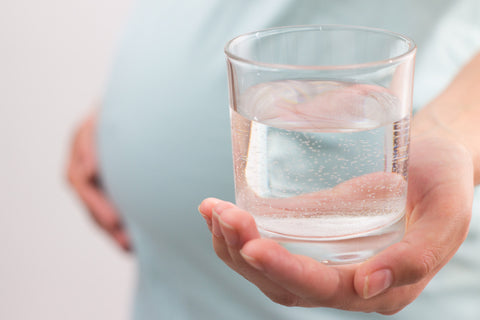As the end of the second-trimester approaches, the realization that you're almost halfway through your pregnancy hits you. It's hard to believe how fast time has flown by! I remember that this point of my pregnancy was pretty much my golden stage. I could feel the “pregnancy glow” going on and I was still able to be pretty active and could move without much discomfort. But I also realize that’s not always the norm. One of my best friends was still making multiple daily visits to face the toilet at 22 weeks… if you know what I mean.
 Got sugar?
Got sugar?
Usually sometime between 24 and 28 weeks, your healthcare provider will have you come in for a pregnancy glucose tolerance test. Glucose (sugar) screening is a blood test that is checking you for gestational diabetes, meaning diabetes that specifically appears during pregnancy. If you’re unfamiliar with diabetes, it is a condition where your body does not regulate sugar properly because it cannot make enough of the hormone insulin. Insulin is released from the pancreas to regulate the amount of sugar in your blood. If not enough of it is being produced, then the levels of sugar in your bloodstream will be too high, which can cause high blood pressure which is unsafe for both mama and baby. This can also lead to a pregnancy complication called pre-eclampsia (symptoms including high blood pressure, high levels of protein in your urine, significant swelling, and more) which can lead to serious issues for baby and potential organ damage for mama. If your doctor finds pre-eclampsia, they will most likely want to induce you early, which may lead to other interventions during labor and delivery.
Long story short, it’s important to prevent and check for gestational diabetes!
The Glucose Tolerance Test
So what is this test, exactly? You consume a sugary drink given to you by your care provider, wait for at least an hour, and then have your blood drawn. Sounds easy, right? When I was early in pregnancy I remember asking other women about their experience with the test, and I heard things like “it was horrible,” “I felt so sick,” “I almost passed out,” etc. So that led me to ask… why does it seem to be the worst thing ever?? So it seems to be boiled down to 2 main things:
- The drink that you have to consume at the beginning of the test is disgusting, and
- You consume a TON of sugar from this drink and then are not allowed to eat for at least an hour
… and it seems like for lots of women, this is a very problematic combination. The nasty sugar drink combined with not being able to eat anything afterwards leads many women to nausea, dizziness, headaches, and jitteriness.
Out of curiosity, I asked my care provider if I could see the label on the glucose test drink when I was near the start of the second trimester. The ingredient list said: purified water, 50g Dextrose (D-glucose derived from corn), Citric Acid, Natural and Artificial Flavors, Sodium Benzoate, 0.1%, FD&C Yellow #6.
Let’s break this ingredient list down a little, shall we?
- Purified water: no problems here!
- 50g Dextrose (derived from corn): First of all, 50 grams of sugar is double the recommended amount per day for a female. Second, dextrose is a highly processed form of sugar that is derived from GMO corn (as in, it is also highly processed and has unhealthy chemicals and pesticides added to it).
- Citric acid: a chemical that serves as a preservative and also gives an acidic flavor to foods and drinks; originally extracted from lemons but due to its high demand in processed foods, it is now usually derived from GMO corn (see above note).
- Natural and artificial flavors: there is absolutely nothing natural about these. These are chemicals derived in a lab to make things taste better. They have zero nutritional value and serve as an all-encompassing umbrella label that allows companies to use pretty much anything and everything (animals, plants, eggs, dairy, & more) to create these flavorant chemicals
- Sodium benzoate 0.1%: This chemical also serves as a preservative and is associated with side effects such as nausea, vomiting, and abdominal pain.
-
FD&C Yellow #6: This is artificial coloring. It is created as a byproduct of petroleum. Several different cancer-causing carcinogens have been found in food dyes, and these are also highly processed and created in a lab.

So what should we make of all that? The information about these ingredients might not personally bother you, and that’s okay! For me, I personally feel pretty strongly about avoiding unnecessary chemical exposures through food and drink, especially during pregnancy. So that’s why I started to figure out if there were any alternatives to this dreaded drink.
Glucose Test Alternatives
There’s 4 other options to this orange or lemon flavored “nasty drink.” They are:
- Check with your care provider to see if they offer another version of the glucose drink that does not contain preservatives or food dyes. My office did, and that drink only contained water and dextrose. Even if your office doesn’t have it in stock, they may be able to order it for you.
- Bring your own glucose drink! Yes, you can totally do this. I recommend The Fresh Test, a lemonade-like powder that you buy yourself, take to your glucose tolerance test, mix with water, and drink. The ingredients are: Non-GMO Dextrose, Crystalized Lemon, and Organic Peppermint Leaf Powder.
- Skip the test and monitor your glucose levels at home for about a week. This is much more time intensive as you will most likely be asked by your healthcare provider to prick your finger several times a day for several days to check your blood sugar levels with a glucometer. But, this method would also negate the need to drink a glucose drink.
- Skip the gestational diabetes screening altogether. Ultimately, it’s your choice! Even if your healthcare provider makes it seem mandatory, technically nothing is mandatory in pregnancy and birth – it’s your body, your baby, and your journey, so it’s up to you. If you don’t have a history of diabetes, it doesn’t run in your family, you’re at a healthy weight, don’t consume lots of junk food and sugar, then you probably have an extremely low risk for GD. Lots of women like to do the test anyway for peace of mind, but if you feel comfortable skipping it, you’re totally allowed to!
For my first pregnancy, I personally opted to use The Fresh Test for my glucose tolerance test. For future pregnancies I may opt out of the test since I am at very low risk for GD, but time will tell for sure on that decision! Whatever you decide to do, it’s probably a good idea to make a decision now, because your healthcare provider will likely schedule you for a screening in the next couple of weeks.
**Please note, nothing in this article is medical advice; it is purely educational. Consult with your healthcare provider if you have questions.
Looking for weekly pregnancy updates & advice from industry experts?

ABOUT THE AUTHOR
Kristen is a Christ follower, wife, mama, and holistic living enthusiast, with a passion for birth photography. Kristen's journey from illness to wellness led her to embrace toxin-free living. She shares her expertise through photography services and valuable tips for holistic living.

















